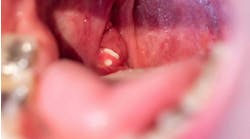Instrument packages ensure safety for patients if sterility is maintained
Chris Miller, PHD
Instrument processing is a very important component of an infection control program since it is directly related to patient safety. Instrument processing consists of cleaning, packaging, sterilizing, and distributing. The ultimate goal is to deliver sterile instruments to chairside for use on the next patient.
Achieving this goal requires that the sterility of the instruments be maintained after they are removed from the sterilizer and until they are exposed at chairside just before use. To accomplish this, the instruments must first be packaged (pouches, wraps, wrapped cassettes) before being placed into the sterilizer. Then after sterilization, the packages must be properly dried, handled, transported, and stored.
Drying instruments
Instrument packages processed through a dry-heat sterilizer or an unsaturated chemical vapor sterilizer (chemiclave) are dry at the end of the sterilizing cycle. However, steam sterilizers yield wet packages at the end of the sterilizing portion of the cycle and should be dried before removing from the sterilizer chamber. If packages are handled and removed from the steam sterilizer while wet, the packaging will likely separate or tear, especially if paper. This obviously compromises the sterility of the package contents. Also, microbe-laden dust particles, or airborne dental spatter/aerosol particles will settle on the packages and the moisture in the packaging material may draw these microbes through to the inside of the package.
Some sterilizers have a 30- to 60-minute "built-in" dry cycle that can be activated at the end of the sterilizing cycle. Drying can also be accomplished by opening the door about half an inch after the sterilizing cycle when the pressure is zero and leaving the door slightly ajar for about 30 minutes before removing the packages. This will permit escape of residual steam, drying, and cooling of the items while they remain in a fairly protected environment.
Sterile packages should always be handled gently so as not to overly compress the package and risk separation or tearing. Never handle the packages with tongs. After removing dry packages from a sterilizer, allow them to cool (if warm) in a low-traffic area at room temperature and not in the path of air conditioning vents. Rapid cooling may lead to unwanted formation of condensation on or in the packages.
Never place sterilized packages in an area that also contains non-sterilized items. There must be no chance the sterile items can be intermingled with non-sterile items. Chemical (process) indicators on the outside of packages will change color after exposure to heat, helping to control this problem. Also, avoidance of any mix-up can be aided by physically separating the sterile items from non-sterile items with the respective areas identified by signs (for example, "sterile" or "not sterile").
Transporting and storing sterile packages
If packages are to be transported to storage areas through an environment that may enhance chances for contamination with moisture or excessive dust, a dust cover should be used. Do not cover warm packages with a dust cover for this can cause condensation formation.
While instruments in most offices are usually not stored for very long, any storage should be under the proper conditions in order to maintain sterility of the packaged instruments. Instrument storage areas should be in a part of the office that has minimal chance for contamination by touching or by dental spatter/aerosols and dust or by moisture.
With that in mind, storage should occur in a cool, dry, enclosed, low-dust area away from the operatory, sinks, outside ceilings and walls, and water or sewer pipes.
Suggestions are about five feet away from sinks, about eight to 10 inches up from the floor (to avoid any moisture from mopping), and about 18 inches away from outside ceilings, at least two inches away from outside walls, and not under pipes containing water (to avoid moisture from condensation).
Out of harm`s way
The storage area should be in a place that is not susceptible to easy contamination by patient materials. Storage of instruments in the operatory increases this risk even if an aseptic retrieval system is in place.
Storage in drawers at chairside is especially conducive to chances for contamination with fingers reaching in to retrieve an item during patient care or by dental spatter/aerosols entering when the drawers are opened. Keeping such drawers closed during patient care can avoid these concerns.
Visually inspect each package as it is placed in the storage area. Any packages that are torn, compressed, or wet should be considered as contaminated and be reprocessed before use.
The shelf-life of a package processed through a sterilizer is the time before the unused packaged should be reprocessed. This time is event-related and not just dependent upon the length of storage time. Event-related means that if an event occurs that may compromise the sterility of the package, then the instruments should be reprocessed.
Such an event may be any of those previously mentioned: becoming wet, compressed, unsealed, brittle from heat, dropped, or obviously separated or torn. Thus, when obtaining packages for chairside use, visually inspect their integrity.
Package rotation should be "first in, first out" using the oldest items first as long as the packaging material is intact.
Chris Miller is director of Infection Control Research and Services and professor of oral biology at Indiana University.





